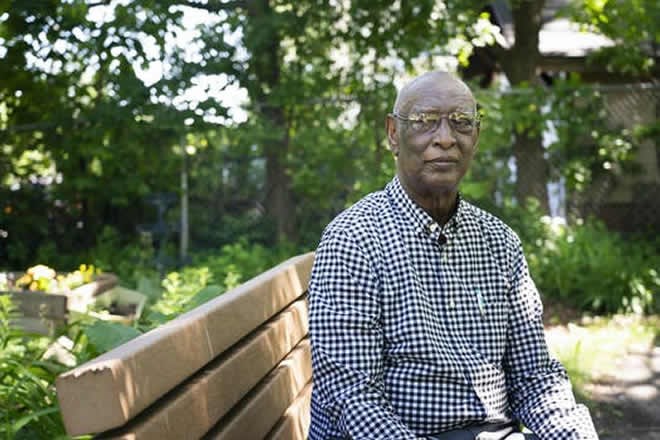
Wednesday June 10, 2020
By Erin Adler
Agencies serving refugees say violent images revived old fears.

Siyad Farah, 90, in the courtyard of his apartment complex in Minneapolis. He grew up in Mogadishu. When the rioting started, “The first thing I thought that was going to happen was a civil war,” he said through a translator. RENÉE JONES SCHNEIDER • [email protected]
As Twin Cities refugees watched the riots following George Floyd’s killing, the violence triggered memories of chaotic scenes in the countries they fled for Minnesota.
“For the refugee population, witnessing police brutality and torture at the hands of an authority figure in broad daylight is going to be extraordinarily triggering,” said Jill Davidson, a social worker with the Center for Victims of Torture. “This was something they thought they left behind.”
Davidson said Minnesota, with its large refugee population, is home to an estimated 50,000 victims of torture — which typically occurred at the hands of a police officer or other authority figures. For her clients, “this [George Floyd] situation has caused a significant setback for, I would say, the majority of them.”
They have been hurt physically or psychologically, sexually assaulted or had food and medical care withheld. Watching Floyd struggle to breathe churned up memories of similar experiences, she said.
Even if not torture victims, many refugees carry trauma from seeing conflict firsthand.
Siyad Farah, 90, was born in northern Somalia and grew up in Mogadishu. He came to the U.S. in 1999, fleeing war, and now lives near Minneapolis’ Third Precinct.
When the rioting started, “The first thing I thought that was going to happen was a civil war,” he said through a translator. Previously, he thought American police had the best training in the world, but watching the video of George Floyd’s last moments changed Farah’s mind. Floyd’s death looked like terrorism, he said, and reminded him of how feared police were in Somalia.
To cope, Farah has been reading the Qur’an and working to stay busy. “I hope things change,” he said.
The blaring sirens, the smell of burning buildings and the sight of the National Guard patrolling the streets has been traumatic for first-generation Somalis, who experienced similar scenes during that country’s civil war.
“They were like, ‘We can’t believe it. This is America,’” said Fartun Weli, executive director of Isuroon, a nonprofit that helps Somali-American women and families.
While Weli was “freaking out” during the protests and the riots, many Somali elders were “incredibly calm,” she said. Then she realized why.
“I was like, ‘Oh, they are in that survival mode where everything is shut down,’ ” she said. For a refugee, it’s an everyday instinct, she added.
Suud Olat, 29, grew up in a Kenyan refugee camp and has been in the U.S. for eight years. He’s running for a seat on the Minneapolis City Council and has heard some Somali-American community members wonder if they will now have to flee their new home.
“They are asking ‘What is going to happen now?’” he said. “The emotional part is that this is in our neighborhood. That’s shocked us and taken a big emotional toll.”
When a person is reminded of past trauma, “even if a person is not in immediate danger, their body responds as if they are,” Davidson explained. Cognitive functioning turns off and a “flight, fight or freeze” response sets in.
They are afraid to go work or leave the house and suddenly fearful of police, she said. Some are having intrusive thoughts, trouble sleeping or waking from nightmares. Others can’t stop crying.
Compounding the problem, some lost access to basics like grocery stores and pharmacies when stores burned down or were looted, Davidson said.
When mayhem erupted on St. Paul’s University Avenue after Floyd’s death, many Hmong-American farmers were driving home from farm fields in rural areas. Most are in their 60s or 70s and have vivid memories of the Vietnam War. Others in the Hmong community tried to alert them to what was happening so they wouldn’t have to see it.
“They escaped a war-torn country to come to America,” said Bao Vang, executive director and CEO of the Hmong American Partnership. “They didn’t expect that the looting, the rioting would happen in broad daylight with no police presence.”
What they saw in St. Paul reminded them of being “hunted and persecuted” in Laos and Thailand, she said. Some took refuge at the suburban home of a family member. Others got back to their house, locked the door and lay awake all night. Still others froze up, focusing only on survival.
The Center for Victims of Torture teaches its clients strategies to regulate their nervous system if they see or hear something that retraumatizes them. They may try to focus intently on one thing, such as a tree or bird outside their window, to ground themselves in the present. Medicine can help, especially if sleep is an issue, Davidson said.
“I am just amazed every day at the resilience of the people we’re working with … and how they still manage to find a way,” she said. “Our community has a lot to learn from them.”
Out of tragedy, Weli said, she sees hopeful signs in the Somali community. Many young people now want to register to vote or learn how to organize their communities. Others hope to become citizens. “Even though it’s really a hard time, I also see opportunities for the community to become more politically active, with intention,” she said.
Mara Klecker contributed to this story.